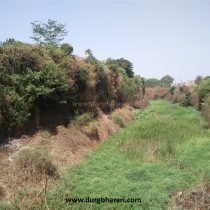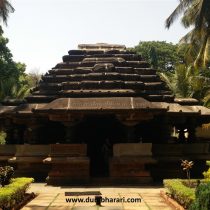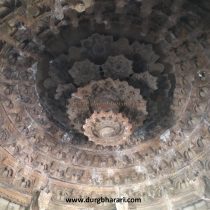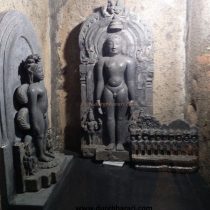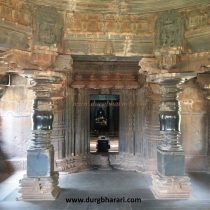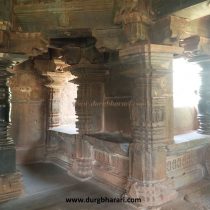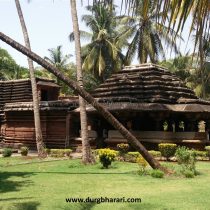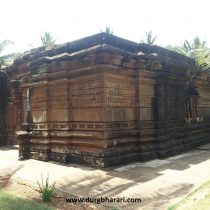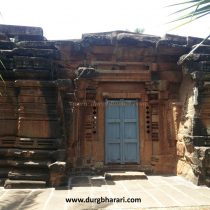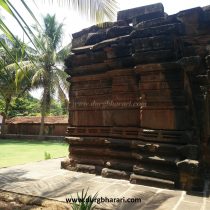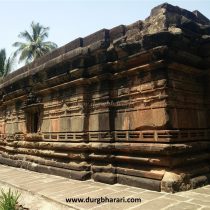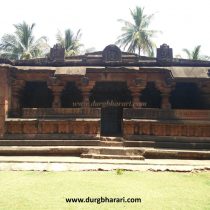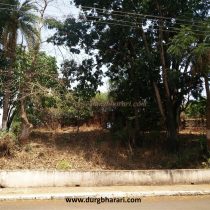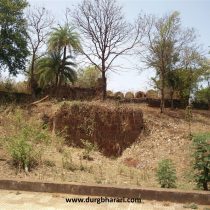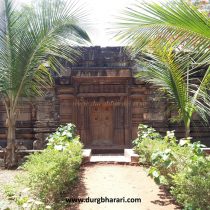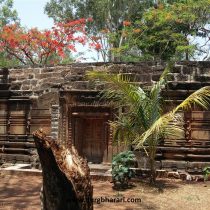BELGAON
TYPE : GROUND FORT
DISTRICT : BELGAON
HEIGHT : 0
GRADE : EASY
The ancient Sanskrit name of Belgaon was Venugram which means bamboo village. The city of Belgaon was founded by the Rashtrakuta rulers of Saundatti in the twelfth century AD. Ratt officer Bichiraja built the Chalukya style Jain temple of Belgaon and Kamal Basti in 1204. Other constructions in the fort date back to 1519 AD. From 1210 to 1250, Belgaon was the capital of Rashtrakuta. The Yadavs of Devgiri defeated the Rashtrakutas and conquered Belgaon. In 1300, Allauddin Khilji defeated the Yadav and Hoysol kings here. In 1336, Vijayanagar rulers captured Belgaon. In 1474, the Bahamani general Mohammad Gawan captured Belgaon, but in 1511, the Bahamani kingdom was overthrown and the Adilshah of Bijapur took advantage of it.
...
. Adilshah improved the fort of Belgaon. Adilshah Yakubali Khan of Bijapur has made an important contribution to the construction of the existing ramparts and moats. The Mughals and the Marathas ruled Belgaon. In 1818, the city was incorporated into his empire. The fort was used as a military base during the British rule. In 1844, the British army marched on Samangad fort from this fort to quell the rebellion of the fort keeper of Samangad. Belgaon fort is at a short distance from the central bus depot of Belgaon city. The fort, located in the center of the city, is under the control of the army, so photography is banned in some areas. The fort has a deep moat along the ramparts and is currently filled with swamps. The fort is fortified with high and strong bastions. After entering through the main entrance of the fort, the first battlefield begins. Below this area is a ditch to descend into the moat which is currently in a partially extinguished state. There is another entrance to the fort on the battlefield and the old wooden doors and the wicket gate are still standing. Inside the gate, on the right side, there is an ancient temple of Ambabai and Ganapati and on the left side, there is a porch for the guards. A partially buried cannon can be seen in the street in front of the door. When you pass through the entrance, this part of the fort has some buildings built during the Adilshah period which now houses the offices of the army and the government. Going further from there, one can see the construction of an arch in Mughal style on the entrance. This part is the base of the Maratha Light Infantry and the recruitment center of the army. There is a Ganapati temple at the back of Ramakrishna Ashram, a little further from the recruitment center. A little further on, there is a beautiful Jain temple in the Chalukya style in the year 1204 with idols of Lord Parshvanath and Neminath. This temple is known as Kamal Basti. This temple is a beautiful example of a sculpture built with black stone. The main pavilion has a magnificent and very beautiful lotus flower chandelier carved on the roof. It is said that this temple got the name Kamalbasti from this sculpture. On the way out of this temple, on the right side, there is another beautiful temple with Chalukya style carvings, but only the prayer hall of this temple remains and the sanctum sanctorum has been destroyed. The Archaeological Department has restored both the temples. The ramparts and two bastions of the fort are visible along the road on the left side of the temple. Apart from the main gate to the south of the fort, there is another gate on the east side next to Kamalbasti. This door was probably built in the latter times. Apart from this, the fort has two mosques named Safa and Jamia of the Adilshahi period and Dargah of Badruddin Shah. As both the mosques are in the military area, there is no entrance but the Dargah can be seen. In the northern part of the fort, there is another Chalukya style carved Shiva temple on the left side next to Kamalbasti, but only the prayer hall of this temple remains and the sanctum sanctorum and the upper part have been destroyed. If you have a private vehicle, you can drive around the fort and see the bastions and ramparts, but you cannot access some places as it is restricted army premises and also there are restrictions on taking photos. To see the entire fort properly you might need one whole day. In the last one thousand years, the Belgaon area was ruled by Chalukya, Kadamba, Rashtrakuta (Ratt) Shilahar, Yadav Vijayanagar, Bahamani, Adilshahi, Marathas, Mughals, and Nizams. Many inscriptions and copperplates of these dynasties have been found in the area. The name Venugram of Belgaon has been found in the inscriptions and copperplates of the Shilahar and Ratt dynasty kings who ruled over this region since 1040 AD and it seems that it was renamed as Belgaon in the later period. The earliest evidence proving that the name of Belgaon was Venugram from a thousand years ago is the inscription found at Raibag in the year 1040 and dates back to the reign of Ratt Raja Kartavirya. In the 15th line of this article, it is mentioned that Kartavirya is ruling Venugram. The inscription mentions that Ratt Nripati Areg donated some land in Malkurubett in Kundi to his Chief Minister Madiraj. The city of Kundi mentioned in this inscription is the western part of the present Belgaon district. Venugram is mentioned in the copperplate given by Shilahar king Gandaraditya. This copperplate is at Valiwade in Kolhapur. This copperplate praises his family in it. It describes the burning of Venugram by Shilahar Raja Bhoj with great prowess. From these two inscriptions, it is clear that the original name of Belgaon was Venugram. When Kadamba ruled over Goa in around 1160, one of his writings mentions the name Velugram. From that, the city of Velugram i.e. Belgaon should firstly be ruled by the Kadamba kings. From 1208 to 1250, Belgaon was ruled by the Rashtrakuta dynasty. The inscription at Hannegiri gives information that Mahamandleshwar (King) of the Rathh dynasty brought his capital to Venugram. Between 1250 and 1327, Belgaon came under the rule of Devagiri Yadavs. From 1327 to 1472, Mohammad Tughlaq invaded South India. He conquered Hukkeri and Raibag and appointed two of his chiefs there. However, the fort and the city of Belgaum and the surrounding area remained under the control of a Hindu chief. In 1472, Mahammad Shah Bahamani marched on the city of Belgaon. At that time Vikramarai, Raja of Belgaon tried his best to protect the fort but he did not succeed. Mohammad Shah entrusted the responsibility of looking after the fort and city of Belgaon to Wazir Mohammad Gawan. He tried to settle the condition of the surrounding area but in 1511 the Bahamani kingdom was overthrown. Adilshah of Bijapur took advantage of it. In 1510 and 1511, Alfonso Albuquerque invaded and conquered Goa. At this time, Adilshah of Bijapur made Khushruturk (Asadkhan) the chief of Belgaon and entrusted the administration of Belgaon to him. Until 1549, Asad Khan ruled over the city of Belgaon. It is said that in the year 1550, Sher Khan established a market at Shahapur near Belgaon city. This was the market of Belgaon city and the fort. An English traveler named Finch came here. He has recorded in his diary that Belgaon is a big city between Goa and Bijapur and there is a big trade of gems like diamonds, rubies, indigo, etc. In 1580, Ibrahim Adilshah's brother Ismail rebelled in Bijapur and Adilshah arrested him and brought him to Belgaon fort. In the year 1674, Shivaji Maharaj was crowned at Raigad. After Maharaj's expedition to the south, he conquered Belgaon and Shahapur and went to Hubli. In the Belgaon area, Shivaji Maharaj built many small forts like Pargad, Bhimgad, Vallabhgad, Rajhansgad, Mahipalgad, Kalanandigad, Pavitragad, Parasgad. In the year 1686, Emperor Aurangzeb invaded the south. Prince Azam conquered the fort of Belgaon, so for some time, Belgaon was called Azamnagar. Mustafakhan, the fort keeper of Belgaon fort, named the Belgaon fort area as Mustafabad but the locals did not get used to these names. In 1695, Jameli Carrie, an Italian traveler, came to Belgaon. Seeing the market of Shahapur and the fort of Belgaum, he noted in his diary that this fort is large, with bastions in various places and strong fortifications. Outside the fort, there is a deep and wide moat filled with water and the defense system of the fort is very low. Taking advantage of the death of Balaji Vishwanath Peshwa in 1720, Nizam Ulmulk of Hyderabad captured the fort of Belgaon and Athani Pargana. Then in 1756, the Peshwas brought Belgaon under their control. From then until 1818, the fort and the city remained in the hands of the Peshwas. The Peshwas appointed Sadashiv Pandit to look after the fort and the surrounding area. In 1818, the fort was conquered by the British after a week-long struggle. After the conquest of Belgaon, the British included it in Dharwad district, but later, considering the central location of the city, Belgaon was made the center of the district from 1836 to 1938 and became an independent district. Mahatma Gandhi was imprisoned in this fort during the freedom movement. The British set up an army camp here and in the post-independence period, the headquarters of the Maratha Light Infantry of the Indian Army was established here. Due to its proximity to the Portuguese-occupied Goa, Belgaon was of military importance even after the British rule. In the Goa Liberation War, Indian troops were sent to Goa from Belgaon. After independence, Belgaon was included under Bombay and after the state reorganization of 1956, it went to Karnataka. Since then, disputes have been raging in Maharashtra and Karnataka over Belgaon.
© Suresh Nimbalkar

